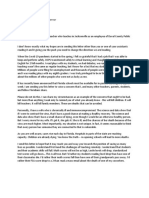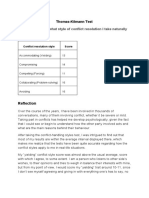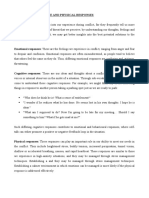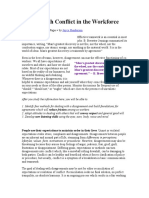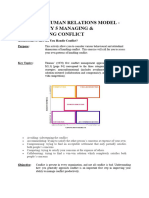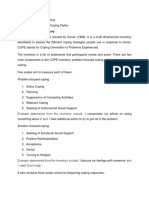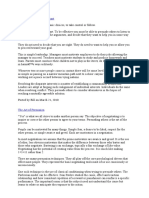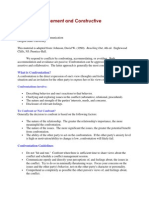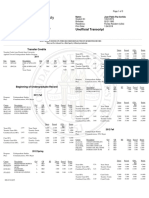Dutch Test For Handling Conflict
Dutch Test For Handling Conflict
Uploaded by
bobCopyright:
Available Formats
Dutch Test For Handling Conflict
Dutch Test For Handling Conflict
Uploaded by
bobOriginal Description:
Original Title
Copyright
Available Formats
Share this document
Did you find this document useful?
Is this content inappropriate?
Copyright:
Available Formats
Dutch Test For Handling Conflict
Dutch Test For Handling Conflict
Uploaded by
bobCopyright:
Available Formats
Dutch Test for handling conflict
Yielding = 11
Compromising = 20
Forcing = 8
Problem Solving = 17
Avoiding = 15
According to this evaluation I range in the moderate to low preference of yielding.
So apparently I dont mind compromising to meet my teammates wishes and I have no
expectations of them for reciprocal help. I am always searching for a middle ground and
am highly willing to compromise to find the common interest of all parties involved.
When it comes to being assertive to full fill my own interests I rank very low in this area.
Forcing other to see things my way is not how I like to get things done. Problem solving
seems to be strength of mine. I will try to a mutual agreement between all involved
parties with little to no conflict. Lastly my score says I will probably avoid conflicts as
much as possible to smooth over an uncomfortable situation.
Yes it is true that I dont like conflict. I always try to remain neutral when an
uncomfortable situation arises. I definitely try to view the situation from everyones point
of view. This way I can have a better understanding of the thought process of everyone
involved. I would say that I am a pretty easygoing, open-minded person. I have a
willingness to resolve (Kearney-Nunnery, 2009, p.131)
I find these assessment tests interesting. They definitely help me reflect on how
the tests perceive me rather that how I perceive my self. They can be seen as both a
positive and a negative. What are the attributes of each individual (Kearney-Nunnery,
2009, p.139). This line from our reading is something to think about when reflecting on
what I can contribute to a team. In the end I think reflecting on the outcomes from these
assessments is always helpful for self-improvement
Lewin, Lippitt, Havelock, Rogers. Proposed many different theories about
change. Change may be planned or unplanned. Unplanned changes bring about
unpredictable outcomes, while planned change is a sequence of events implemented to
achieve established goals. Lewin identified forces that are supportive of as well as those
barriers to change; he called these driving and restraining forces (Kelly, p.303). Lippitt is
all about communication to promote change. His theory included seven steps that are
good when implemented for general change. Havelocks theory included six steps with
the end goal to focus on accepting change. His focus was on overcoming resistance to
change. Rogers theory emphasizes timing and format to ensure that the change process is
adopted.
Reference:
Kearney-Nunnery, R.K. (2012). Advancing your career: Concepts of professional
nursing (6th ed.). Philadelphia, PA: F. A. Davis
Kelly, P.K. (2011), Nursing Leadership & Management (3rd ed.). Clifton Park. N.Y.:
Delmar
You might also like
- The Mindful Guide to Conflict Resolution: How to Thoughtfully Handle Difficult Situations, Conversations, and PersonalitiesFrom EverandThe Mindful Guide to Conflict Resolution: How to Thoughtfully Handle Difficult Situations, Conversations, and PersonalitiesNo ratings yet
- Spirituality Assessment ScaleDocument4 pagesSpirituality Assessment Scalerevlak27767% (3)
- Cisi ExamsDocument2 pagesCisi ExamsNitin Collapen100% (1)
- Respiratorysystem-Lesson PlanDocument5 pagesRespiratorysystem-Lesson Planapi-250802146100% (2)
- An Open To Letter To Florida's GovernorDocument2 pagesAn Open To Letter To Florida's GovernorActionNewsJaxNo ratings yet
- Ielts Speaking Feedback FormDocument1 pageIelts Speaking Feedback FormThắng NguyễnNo ratings yet
- 827 Principles of Microeconomics 12th EditionDocument5 pages827 Principles of Microeconomics 12th Editionakmal sopyanNo ratings yet
- 7 Habits of Highly Effective PeopleDocument5 pages7 Habits of Highly Effective PeopleCisse100% (1)
- 7 Habits of Effect PeopleDocument4 pages7 Habits of Effect PeopleMaserati. MT100% (1)
- The Way To BeDocument168 pagesThe Way To BeMisterSarmoung100% (7)
- Capstone Negotiation and Conflict Resolutions FinalDocument14 pagesCapstone Negotiation and Conflict Resolutions Finalapi-439919392No ratings yet
- Or How To Know What Style of Conflict Resolution I Take NaturallyDocument3 pagesOr How To Know What Style of Conflict Resolution I Take NaturallySimion NechitiNo ratings yet
- Assignment HabitsDocument6 pagesAssignment HabitsMohammad TanveerNo ratings yet
- Conflict Additional MaterialDocument4 pagesConflict Additional MaterialmussawirshahNo ratings yet
- Motivational Interviewing Role-Play Essay Alcohol/Drug Abuse Counseling Jeff Zimmerman 8/16/15Document12 pagesMotivational Interviewing Role-Play Essay Alcohol/Drug Abuse Counseling Jeff Zimmerman 8/16/15api-302777931No ratings yet
- The 7 Habits of Highly Effective PeopleDocument16 pagesThe 7 Habits of Highly Effective PeoplemadochiwendaNo ratings yet
- PT ObDocument3 pagesPT ObSana HashmiNo ratings yet
- Powerful Lessons in Personal ChangeDocument10 pagesPowerful Lessons in Personal ChangeRohit LambaNo ratings yet
- Interpersonal BehaviourDocument27 pagesInterpersonal BehaviourRahulDahiyaNo ratings yet
- Parent Effectiveness Training (PET) / Nonviolent Communication (NVC) My Thoughts On Similarities and DifferencesDocument4 pagesParent Effectiveness Training (PET) / Nonviolent Communication (NVC) My Thoughts On Similarities and DifferencesCate CrombieNo ratings yet
- Dealing With Conflict in The WorkforceDocument5 pagesDealing With Conflict in The WorkforcerpraveenkrishnaNo ratings yet
- Approaches To Conflict ResolutionDocument39 pagesApproaches To Conflict ResolutionAce ColosoNo ratings yet
- Seven Principles of Communication in Conflict ResolutionDocument4 pagesSeven Principles of Communication in Conflict ResolutionTarun ThakurNo ratings yet
- Conflict ManagementDocument8 pagesConflict ManagementKhuzaema Gauhar SiddiquiNo ratings yet
- Mahoghany Andrews, Julie Messersmith, Sheryl Pickering, Casey Anderson, and Allison Smidt Com 301 Ua Gina RollingsDocument33 pagesMahoghany Andrews, Julie Messersmith, Sheryl Pickering, Casey Anderson, and Allison Smidt Com 301 Ua Gina RollingsNarayanan SubramanianNo ratings yet
- Maj. ® Nazir Hussain ShahDocument26 pagesMaj. ® Nazir Hussain ShahDilshad ShahNo ratings yet
- Conflict Management StyleDocument3 pagesConflict Management StyleshimaNo ratings yet
- 7 Habbits Stephen CoveyDocument7 pages7 Habbits Stephen CoveyAndhika DaffaFTNo ratings yet
- ADR PresentationDocument79 pagesADR PresentationXandra Yzabelle T. EbdalinNo ratings yet
- Conflict Resolution: Positive and Negative TechniquesDocument33 pagesConflict Resolution: Positive and Negative TechniquesJOHN MICHAELNo ratings yet
- I Peer Mediation Intro Notes 2019 EmailDocument6 pagesI Peer Mediation Intro Notes 2019 EmailEmma PreciousNo ratings yet
- Be Proactive, Personal VisionDocument6 pagesBe Proactive, Personal VisionArooj ArshadNo ratings yet
- Pearl 2Document11 pagesPearl 2api-535000623No ratings yet
- Milandeep Kaur MaanDocument9 pagesMilandeep Kaur MaanDeejay DheerajNo ratings yet
- The 7 Habits of Highly Effective People-Synopsis by Bonus AsingwireDocument5 pagesThe 7 Habits of Highly Effective People-Synopsis by Bonus AsingwireAsingwire BonusNo ratings yet
- Step 2: BAS-8 Group 6 - HW2.1: Team AnalysisDocument6 pagesStep 2: BAS-8 Group 6 - HW2.1: Team AnalysisThư NguyễnNo ratings yet
- Motivational Interviewing GuideDocument22 pagesMotivational Interviewing Guideketo.el.3men2No ratings yet
- WEEK 4 - Exercise 1 - How Do You Handle Conflict - AssessmentDocument3 pagesWEEK 4 - Exercise 1 - How Do You Handle Conflict - AssessmentAyesha IrumNo ratings yet
- Chapter 2Document2 pagesChapter 2Gaaddisaa UsmaanNo ratings yet
- 7 Habits-of-Highly-Effective-PeopleDocument5 pages7 Habits-of-Highly-Effective-Peoplekhaisar818No ratings yet
- Leadership Lesson 8Document12 pagesLeadership Lesson 8'Hasan ibn-Sabah'No ratings yet
- Lesson 1 Individual Activity Emotional-Intelligence-Eq-AssessmentDocument3 pagesLesson 1 Individual Activity Emotional-Intelligence-Eq-AssessmentDesmond TanNo ratings yet
- Conflict Management StyleDocument3 pagesConflict Management StyleSalma BanuNo ratings yet
- NCM 117-Assignment 1Document8 pagesNCM 117-Assignment 1karen carpioNo ratings yet
- Soft Skill 1Document43 pagesSoft Skill 1RAVI GIRI GOSWAMINo ratings yet
- Assertive Communication Is The Straightforward and Open Expression of Your NeedsDocument6 pagesAssertive Communication Is The Straightforward and Open Expression of Your NeedsSunitha Konda100% (1)
- 7 Habits of Effective PeopleDocument5 pages7 Habits of Effective Peoplemeh RanNo ratings yet
- Negotiating - A Contact SportDocument13 pagesNegotiating - A Contact SportChandan ChakrabortyNo ratings yet
- Freedom FlightDocument1 pageFreedom Flightdocwavy9481No ratings yet
- Hanna - 70 Strategies and Techniques For Counseling Difficult AdolescentsDocument32 pagesHanna - 70 Strategies and Techniques For Counseling Difficult AdolescentsoscarcortinaNo ratings yet
- Book ReviewDocument4 pagesBook ReviewSuresh KumarNo ratings yet
- The 7 Habits of Highly Effective PeopleDocument16 pagesThe 7 Habits of Highly Effective PeopleAmanie OthmanNo ratings yet
- Edu401 Lesson 11 12Document6 pagesEdu401 Lesson 11 12Abdullah G.RNo ratings yet
- How Can We Make Conversations More Prosocial?: Giving Good InformationDocument7 pagesHow Can We Make Conversations More Prosocial?: Giving Good InformationJuan Esteban AfanadorNo ratings yet
- Dealing With ConfrontationDocument5 pagesDealing With Confrontationdanny_93_mx8845No ratings yet
- Week 11 The Beauty of ConflictDocument2 pagesWeek 11 The Beauty of ConflictPrince Jewelry Dave JulianoNo ratings yet
- Resolving Conflict: Ten Steps for Turning Negatives into PositivesFrom EverandResolving Conflict: Ten Steps for Turning Negatives into PositivesNo ratings yet
- 4-Conflict Management AssignmentDocument7 pages4-Conflict Management Assignmentapi-299108235No ratings yet
- Nadeeka Rathnayake Seminar 4Document1 pageNadeeka Rathnayake Seminar 4Nadeeka RatnayakeNo ratings yet
- Managaing ConflictDocument17 pagesManagaing ConflictSaman ChauhanNo ratings yet
- The 7 Habits of Highly Effective People: Presented by Framed byDocument25 pagesThe 7 Habits of Highly Effective People: Presented by Framed byAssiddiq BourihaneNo ratings yet
- Assertive CommunicationDocument6 pagesAssertive CommunicationDivya100% (1)
- Quiz #2 Study GuideDocument2 pagesQuiz #2 Study Guidebrenda.n.diazNo ratings yet
- Uh 120 Reflection Paper 6Document5 pagesUh 120 Reflection Paper 6api-486734489No ratings yet
- Form Bof PSIDocument2 pagesForm Bof PSIossamachatri2No ratings yet
- Conflict ResolutionDocument40 pagesConflict ResolutionScribdTranslationsNo ratings yet
- (Menander (Of Laodicea)Document439 pages(Menander (Of Laodicea)alinm_escu100% (1)
- Chapter 1Document9 pagesChapter 1Juriel BarredoNo ratings yet
- Grade 4 English DLL 1st Quarter Week 6-9 - Anna Pearl Darling RupisanDocument67 pagesGrade 4 English DLL 1st Quarter Week 6-9 - Anna Pearl Darling RupisanJeclyn D. Filipinas100% (1)
- Individualism and Collectivism in Billboard AdvertisementsDocument18 pagesIndividualism and Collectivism in Billboard AdvertisementsELTE BTK HÖK Tudományos Bizottság100% (2)
- CV KaluarachchiDocument4 pagesCV KaluarachchighaslNo ratings yet
- CN329 14166 Exam Timetable ComponentDocument1 pageCN329 14166 Exam Timetable ComponentengrroyNo ratings yet
- 2020 APP-CSE TemplateDocument316 pages2020 APP-CSE TemplateJanine Jordan Canlas-BacaniNo ratings yet
- Adult Literacy Games PDFDocument28 pagesAdult Literacy Games PDFAdesti KomalasariNo ratings yet
- Edexcel GCSE 2009 Drama - SpecDocument58 pagesEdexcel GCSE 2009 Drama - SpecMinhalNo ratings yet
- Republic of The Philippines Position Description Form DBM-CSC Form No. 1Document3 pagesRepublic of The Philippines Position Description Form DBM-CSC Form No. 1shiva avelNo ratings yet
- Reading A Scientific Paper For Psychology and The Social Sciences: A Critical GuideDocument9 pagesReading A Scientific Paper For Psychology and The Social Sciences: A Critical GuideLaiba SamadNo ratings yet
- Parent Newsletter - LH 9 18 17Document2 pagesParent Newsletter - LH 9 18 17api-376936481No ratings yet
- CFPB Building Block Activities Spending-Scenarios GuideDocument6 pagesCFPB Building Block Activities Spending-Scenarios GuideMuhammad FaisalNo ratings yet
- Secrets of The Third Sacred School by UrandaDocument3 pagesSecrets of The Third Sacred School by UrandaGary Courtland-Miles100% (1)
- Effect of Transformational Leadership On Employees' Job Satisfaction andDocument8 pagesEffect of Transformational Leadership On Employees' Job Satisfaction andAbetare DomiNo ratings yet
- 8ohbfa 82ccbb6bd8 Listening Skills NotesDocument4 pages8ohbfa 82ccbb6bd8 Listening Skills NotesalberrtoflorindoNo ratings yet
- AcknowledgementDocument5 pagesAcknowledgementAsghar KhalilNo ratings yet
- DISJIMQUARTER4Document4 pagesDISJIMQUARTER4di jimNo ratings yet
- T e 1715772043 Oliver Twist Character Description Mind Map - Ver - 1Document1 pageT e 1715772043 Oliver Twist Character Description Mind Map - Ver - 1najwa sriwaNo ratings yet
- The Honorable Ones The Principle of SMA Negeri 01 TanjungDocument1 pageThe Honorable Ones The Principle of SMA Negeri 01 TanjungAnonymous rNBKwCNo ratings yet
- Unofficial Transcript Undergraduate GraduateDocument5 pagesUnofficial Transcript Undergraduate Graduateapi-392136152No ratings yet
- Lesson 20 Homework 5.4Document4 pagesLesson 20 Homework 5.4g3w33y1q100% (1)
- Character Education A Book Guide For Teachers, Librarians, and ParentsDocument2 pagesCharacter Education A Book Guide For Teachers, Librarians, and ParentsM Andika RobiansahNo ratings yet
- Tintin DLPDocument11 pagesTintin DLPAnielof TandogNo ratings yet




